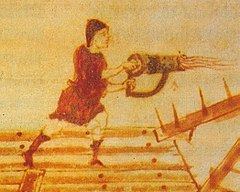Start date 1043 | ||
 | ||
Similar Sviatoslav's invasion of Bulgaria, Siege of Constantinople, Siege of Dorostolon, Battle of the Alta River, Battle of the Stugna River | ||
Rus byzantine war 1043
The final Rus'–Byzantine War was, in essence, an, unsuccessful naval raid against Constantinople instigated by Yaroslav I of Kiev and led by his eldest son, Vladimir of Novgorod, in 1043.
Contents
The reasons for the war are disputed, as is its course. Michael Psellus, an eyewitness of the battle, left a hyperbolic account detailing how the invading Kievan Rus' were annihilated by a superior Imperial fleet with Greek fire off the Anatolian shore. According to the Slavonic chronicles, the Kievan fleet was destroyed by a tempest.
The Byzantines sent a squadron of 14 ships to pursue the dispersed monoxyla of the Rus'. They were sunk by the Kievan admiral Ivan Tvorimich, who also managed to rescue Prince Vladimir after the shipwreck. A 6,000-strong Kievan contingent under Vyshata, which did not take part in naval action, was captured and deported to Constantinople. Eight hundred of the Rus' prisoners were blinded.
Vyshata was allowed to return to Kiev at the conclusion of the peace treaty three years later. Under the terms of the peace settlement, Yaroslav's son Vsevolod I married a daughter of Emperor Constantine Monomachus. Vsevolod's son by this princess assumed his maternal grandfather's name and became known as Vladimir Monomakh.
Crimean campaign of 1044
There are good reasons to believe that the campaign was not over in 1043 (as Greek sources seem to imply), but continued with the Rus' capture of Chersonesos (Korsun') the following year:
Careful analysis of these facts led Vera Bryusova to conclude that hostilities were renewed in 1044 or 1045, when Vladimir advanced on Chersonesos and captured it, retaining the town until the Byzantines, involved in several other wars, agreed to conclude a favourable treaty with Rus' and give a princess in marriage to his younger brother. If so, the situation would be almost identical to the conquest of Chersonesos by Vladimir the Great, which, according to most Slavonic sources, precipitated the Christianization of Kievan Rus' back in 988.
Bryusova argues that later pious legends confused Vladimir of Novgorod with his more famous grandfather and canonized namesake, who most likely never waged wars against Byzantium. Some late medieval authors went as far as to ascribe this Crimean campaign to another celebrated Vladimir, Monomakh, who in fact derived his main foreign support from Constantinople. For instance, Vasily Tatishchev, writing in the 18th century from much earlier sources, erroneously reports that Monomakh engaged a Greek governor of Chersonesos in single combat.
